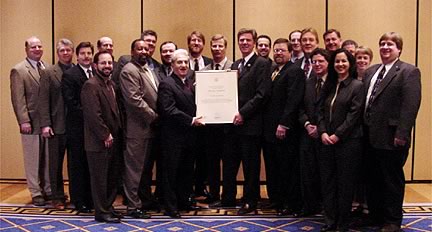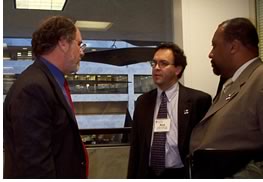

Associate Editor
Grassroots convention participants met with their members of Congress to advance AIA's legislative priorities and to connect with the people who represent their interests in Washington during Government Affairs Day, February 28.
In several meetings with the representatives and senators themselves or with members of their staffs, the AIA representatives sought to present themselves as knowledgeable resources on issues that have relevance to the work of Congress and to their constituents at home.
One component's experiences
This section highlights the experiences of the AIA New Jersey chapter,
which began its legislative efforts Wednesday evening when the local components
gathered after the opening plenary. Strategizing about efforts to meet
with as many members in the state's congressional delegation as possible,
Joseph A. Simonetta, executive director of AIA New Jersey dispersed briefing
materials and dispensed advice about meeting with Congressional representatives.
Simonetta urged the members to be spokespeople for the AIA and its priorities.
Noting that people often only have a short time to make their case, he
said they should plan to "get the issues up front quick."
In his briefing, Board Director Martin Santini, FAIA, president of the Architects League of Northern New Jersey and a past president of AIA New Jersey, advised the members to take advantage of this "exciting and challenging experience" and to use this as an opportunity to develop and exercise their leadership skills.
William Brown, III, AIA, AIA New Jersey President, saw the conference as a way to develop relationships with other AIA chapters and members. For example, he planned to continue the relationship he had been developing with Frederic Bell, FAIA, executive director of AIA New York.

Taking to the Hill
Prior to the AIA's morning legislative briefing, the AIA New Jersey contingent
had the opportunity to greet one of its own, U.S. Rep. Frank Pallone (D),
before he received an Honorary Membership in the Institute.
Then, equipped with a legislative talk by Government
Affairs Managing Director Lisa Blackwell, tips on communicating with Congress
by lobbyist and ex-staffer Stephanie Vance, and issue briefing papers
prepared by the national component to hand to Congressional staff, Legislative
Affairs Day participants eagerly met with their representatives to talk
about AIA's core issues:
• Building security through design
• Truthfulness Responsibility and Accountability in Contracting Act
(TRAC)
• Energy efficiency in buildings
• Shool modernization.
At their first stop, Bill Brown, Santini, and Simonetta, met with Jeffrey Rosato, a legislative assistant in Sen. Robert Torricelli's (D) office. The New Jerseyites expressed their thanks for the senator's support of brownfields legislation and school modernization legislation. The constituents offered their continuing support on environmental issues and said they would be happy to collaborate on a newsletter article about Torricelli's work on school modernization issues. "It's good to know. We'll touch base with you," Rosato replied enthusiastically.
Brown also articulated the ways in which architects can find creative ways to help make buildings more energy efficient, and the legislative assistant noted that Torricelli is on the finance committee, which is in the process of devising legislation that would offer tax credits and incentives for energy efficiency in new housing and other projects. "We're with you on that," Rosato noted.
Brown and Santini presented the AIA Security by Design pin and the Building Security Through Design primer. They also talked about TRAC legislation, and stressed the importance of the senator's support of the exemption for the architectural services that is now a part of the Senate version of the bill. The legislative assistant asked Brown and Santini to get back in touch when the bill goes to conference committee.
"You're looking at issues and things that Congress finds important, and you'll all be part of the process" as time goes on, Rosato said.
Other visits
With a hectic schedule in place, Brown dropped by Rep. Donald Payne's
(a personal friend) office to pass along the AIA's issue briefs and Security
by Design pin, while in another House office building, Wendy Cettina,
AIA, and Jack Purvis, AIA, of AIA Jersey Shore component were meeting
with Rep. Pallone, Hon. AIA. They reported that Pallone spent about 15
minutes with them and was receptive to all the issues they brought up.
Cettina said Pallone noted that security issues are here to stay and noted
that people would feel more secure if security was more incorporated into
architectural design. They also talked about the different views of TRAC
legislation and invited him to their next chapter meeting. They discussed
the possibility of including an article on an energy-efficiency related
topic. Cettina and Purvis also met with Katie Conaway, a legislative assistant
in Rep. Chris Smith's (R) office. After discussing the four legislative
agenda items, Purvis asked Conaway to provide information for the component's
upcoming newsletter. Conaway said she would try to make the deadline for
the next issue.
 Last
but not least, Senator Corzine
Last
but not least, Senator Corzine
Back in the Hart Senate office building, Bill Brown went with AIANY President
Ric Bell, FAIA, to meet with Sen. Jon Corzine (D). Seizing the opportunity
to speak with the state's most newly-elected senator, Bell and Brown caught
up with Corzine as they walked into the office, stressing the need for
regional cooperation on rebuilding lower Manhattan. Corzine noted how
important it is to use transportation infrastructure as a catalyst for
the rebuilding of downtown Manhattan. Bell and Brown then met with members
of Corzine's staff and presented them with the New York New Visions report,
and again talked about the collaboration that resulted in the report,
the need for a memorial process as a starting point for rebuilding efforts,
and their desire to see more funds appropriated for that effort. (Brown
worked for the Port Authority of New York and New Jersey, on the 88th
floor of the World Trade Center. He drove his son to school September
11, and was late for work that day. He lost 35 friends in the attack.)
While they noted that a memorial process does not preclude other development
from going forward, they believe that "respect needs to be paid to
those who lost their loved ones." They also advocated the idea that
Federal Emergency Management Agency funds that are slated for "in-kind"
renovations should be reviewed. Bell said lawmakers may need to "rethink
what replacement in kind means" when the landscape of the items to
be replaced has changed so dramatically.
Wrapping up
The AIA New Jersey delegation is just one example of the way in which
AIA members have the power to influence and frame the issues that are
on our lawmakers' agendas. Santini, Brown, and the other members of AIA
New Jersey demonstrated to their congressional representatives and senators
that they have a command of the issues that are important in their districts
and states, and that they are willing to be a resource for future collaboration
and partnerships.
(Ed. note: The author would like to thank AIA New Jersey for their graciousness!)
Copyright 2002 The American Institute of Architects. All rights reserved.
![]()
|
"A Guide to Legislative Lobbying at Grassroots 2002 or closer to Home" |
|